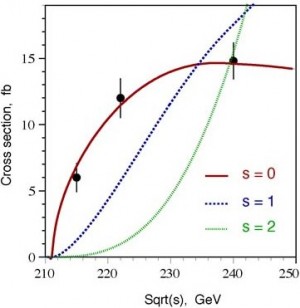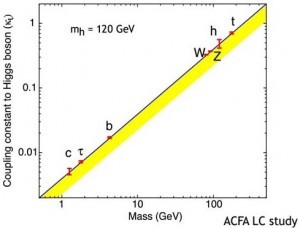
An illustration of how the Higgs spin can be determined at the ILC by studying the behaviour of the cross section from production threshold.
The Higgs boson is being eagerly sought by particle physicists at the Large Hadron Collider (LHC) at CERN because it would explain how elementary particles get their mass, a process called spontaneous electroweak symmetry breaking. The discovery of a new phenomenon, maybe the Higgs boson, at the LHC at around 125 GeV could validate this concept, and open up a future focus of particle physics research to understand how the Higgs mechanism manifests itself. For example, is it a simple Higgs or is it a more complex version? Although it is too soon to know what additional information will be uncovered from the LHC experiments, the potential for exploiting Higgs physics at the ILC provides a graphic example why we will need an electron-positron collider that is complementary to the LHC’s proton-proton collisions.
The Higgs mechanism is a completely new phenomenon in particle physics and its discovery will open up a totally new and very important area of research. To illustrate the potential power of the ILC to study Higgs physics, I give two examples of how the ILC can shed light on this new physics.
In order to prove that what has been observed at the LHC is actually a Higgs, it will be necessary to demonstrate that its spin is zero. The ILC has the ability to measure the particle’s spin directly by tracking the behaviour of the production cross section as the collision energy is increased from the Higgs’ threshold. This ability results from the fact that for electron-positron collisions the full centere-of-mass energy is transferred to the final annihilation products, the particles that are created in the collision, including the Higgs. The cross-section behaviour from threshold then depends on the spin, and particles of spin zero can thus easily be distinguished from those having spin 1 or spin 2.

The Higgs coupling strengths are proportional (or nearly proportional) to mass, which can be tested at the ILC.
A second unique feature of the Higgs boson is that the Higgs field is responsible for the particles’ masses, and therefore the Higgs boson’s coupling strength is proportional to mass. Measuring how the Higgs couples to different constituent particles having different masses will not only demonstrate that this coupling relationship exists, but thanks to many collisions at the ILC, quantitative measurements of the different coupling strengths will enable distinguishing between different models of the Higgs.
The potential discovery of the Higgs is a very exciting development for particle physics! As the evidence grows, we are beginning to uncover the new physics territory being opened up by the LHC. For physicists who have worked so hard and so long developing the LHC and its detectors, this is a rewarding payoff. For those of us working towards a future complementary linear collider, the Higgs discovery will provide strong motivation to propose a machine to complement the LHC, and we are working hard to optimise our design to exploit the results being reported from the LHC.


Recent Comments